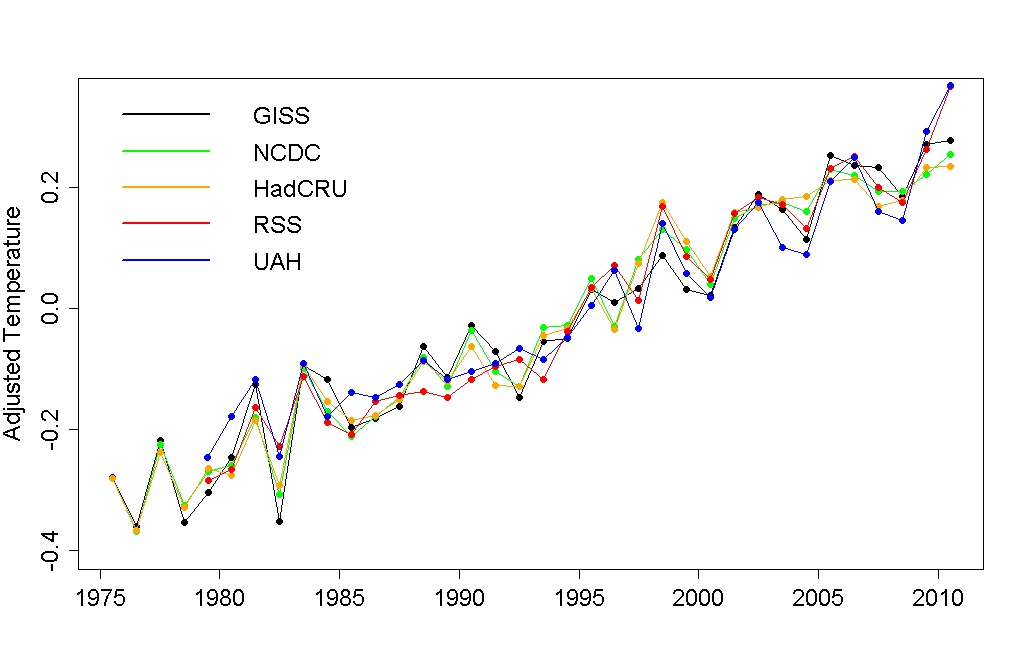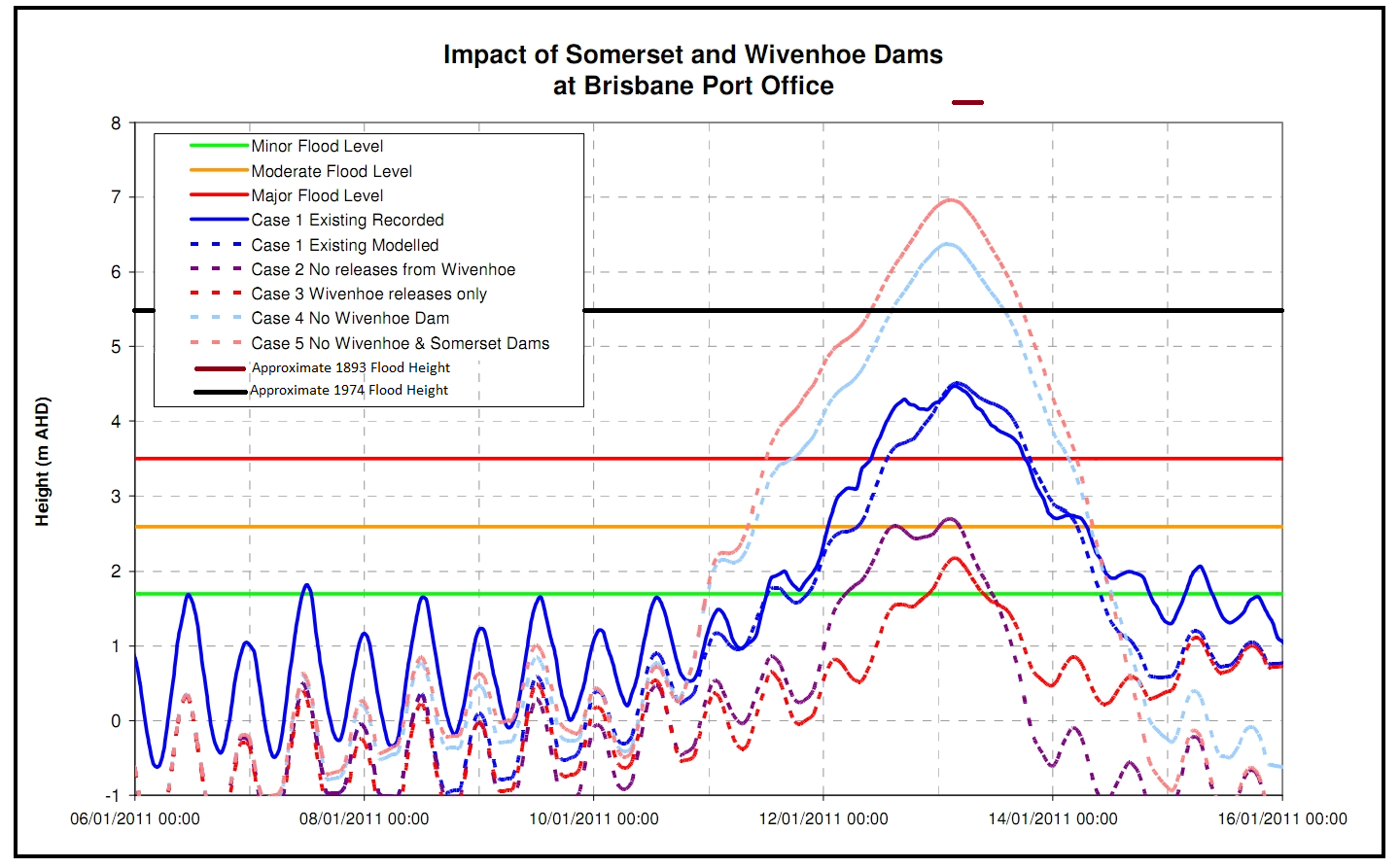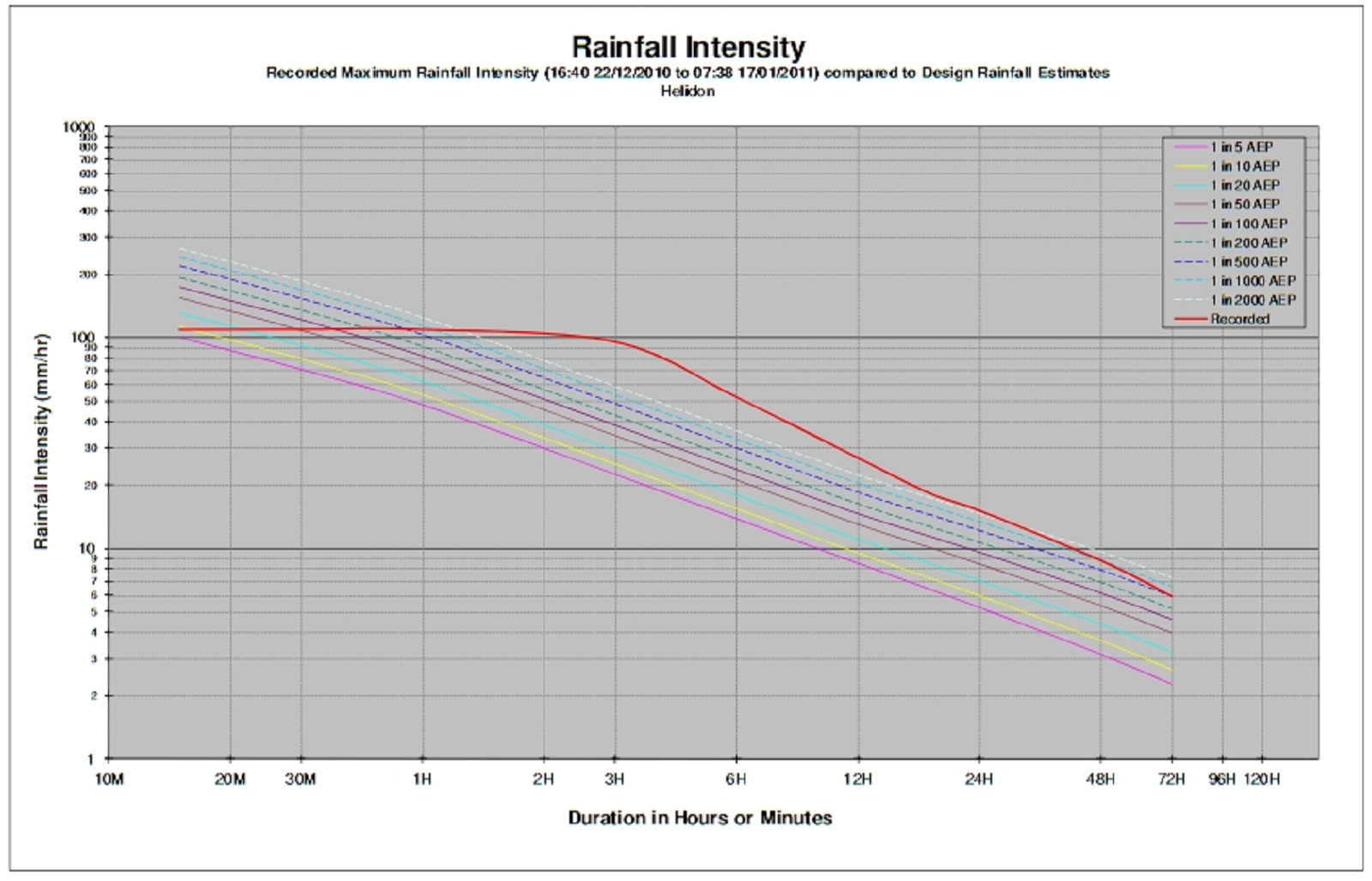Christy's Unconvincing Congressional Testimony
Posted on 10 March 2011 by dana1981
On 08 March 2011, the U.S. House Energy and Commerce Subcommittee on Energy and Power held a hearing entitled entitled “Climate Science and EPA’s Greenhouse Gas Regulations.” As the US Environmental Protection Agency (EPA) has begun regulating greenhouse gas emissions from large sources, Congressional Republicans are seeking justification to revoke their authority to do so through the Energy Tax Prevention Act (H.R. 910). This hearing was held to allow scientists from both "sides" to present their case as to whether our understanding of climate science justifies the EPA's greenhouse gas regulations.
One of the top witnesses called by the Republicans was Dr. John Christy. His full written testimony can be viewed here. Most of the quotes below come directly from that written testimony. As we'll see below, Christy's case for continuing on our current path and revoking the EPA's greenhouse gas regulation authority is primarily based on a repetition of a number of long-debunked myths.
Extreme Weather
Christy began his written testimony by discussing various recent extreme weather events, and arguing that they cannot be attributed to human greenhouse gas emissions.
As Francis Zwiers noted in his testimony for this hearing, while individual extreme weather events cannot be blamed on global warming, "two new papers in Nature (Min et al. 2011, Pall et al. 2011) have presented evidence that changes in the intensity of extreme precipitation since the middle of the 20th century may be linked to human induced global warming, and that in at least one instance, that human influence on climate had likely substantially increased the risk of flooding." Other recent research has detected a human influence in observations of extreme temperatures (e.g., Christidis et al., 2005, 2010; Zwiers et al., 2011).
Temperature Trend
"In 1994, Nature magazine published a study of mine in which we estimated the underlying rate at which the world was warming by removing the impacts of volcanoes and El Niños (Christy and McNider 1994.)...The result of that study indicated the underlying trend for 1979-1993 was +0.09°C/decade...I have repeated that study for this testimony with data which now cover 32 years...In an interesting result, the new underlying trend remains a modest +0.09 C/decade for the global tropospheric temperature"
Christy's method of filtering out the El Niño influence – by removing the tropical sea surface temperature (SST) trend – seems like a rather blunt and imprecise way to remove the El Niño Southern Oscillation (ENSO) signal. After all, the tropical sea surface temperatures could have an upward trend for other reasons (for example, due to an increased greenhouse effect!). Christy's assumption that the tropical SST trend could only be due to ENSO seems unjustified.
In 2008, David Thompson attempted to extract the ENSO signal from the HadCRUT3v data using a different methodology, and Gavin Schmidt applied the same approach to the GISTEMP data. They found that removing the ENSO signal from the surface temperature data did not change the global warming trend over the past 30 years.
Similarly, Tamino recently removed the estimated impact of El Niño, volcanic eruptions, solar variation, and the residual annual cycle from various global temperature data sets (Figure 1).

Figure 1: Adjusted annual average temperature data with the estimated impact of El Niño, volcanic eruptions, solar variation, and the residual annual cycle removed (Source: Open Mind)
The resulting average warming trend is approximately 0.17°C per decade; embarrassingly enough, even Christy's own UAH data show 0.16°C per decade, far larger than 0.09°C per decade trend of his testimony.
Moreover, as the name suggests, ENSO is an oscillation. It alternates between positive and negative states, and thus does not cause long-term warming trends. ENSO also does not create or retain heat; it just moves heat from oceans to air and vice-versa. Thus, even if it caused a surface air warming trend (like 35% of the warming over the past 32 years, as Christy argues), the oceans would cool correspondingly, which they are not. Thus it appears that Christy's reduced warming trend is a result of his imprecise method of attempting to remove the ENSO influence.
Should Have Seen More Warming?
"+0.09 C/decade for the global tropospheric temperature...is still only one third of the average rate the climate models project for the current era (+0.26°C/decade.)"
As we've previously examined, the Earth's surface temperature is warming almost exactly as much as climate models expect. However, it's true that climate models also expect the lower troposphere to warm slightly faster than the surface, and that according to UAH, it is not. That being said, the discrepancy may very well be due to difficulties in analyzing the raw satellite data, which is fraught with problems like orbital decay of the satellites, and the challenge in isolating each different layer of the atmosphere.
UAH does not have the only approach to analyzing the satellite data. For example, Fu et al. (2004) apply a slightly different correction to attempt to isolate the lower troposphere temperatures, and conclude:
“The resulting trend of reconstructed tropospheric temperatures from satellite data is physically consistent with the observed surface temperature trend. For the tropics, the tropospheric warming is ~1.6 times the surface warming, as expected for a moist adiabatic lapse rate.”
Vinnikov & Grody (2006) have suggested that the method used by the UAH group was insufficient to compensate for the impact of the diurnal cycle on the observations. Like Fu et al., their work concludes that the troposphere is warming faster than the surface, as climate models expect.
"The observations at the surface and in the troposphere are consistent with climate model simulations...The resulting global averaged tropospheric trend is +0.20 K/10 yr"
In fact, as tamino noted,
"All the [satellite lower troposphere temperature] analyses except UAH are compatible with computer model projections of tropospheric warming; the error ranges include the values expected from model simulations."
Perhaps Christy should consider the possibility that the problem is not that the troposphere isn't warming as much as climate models expect, but rather that his analysis is (still) underestimating the troposphere warming rate. After all, UAH does not have a stellar track record when it comes to accurate data analysis.
Heating from Land Use Changes
"warming is dominated by increases in nighttime temperatures, with little change in daytime temperatures. This pattern of warming is a classic signature of surface development (land cover and land use change) by human activities."
Actually, greater warming during the night than day is a key signature of an increased greenhouse effect.
Christy's argument here is not very different from blaming instrumental global warming measurements on the urban heat island (UHI) effect. However, scientific organizations make great efforts to remove these types of local influences, and according to Menne (2010), are very successful in doing so. That's why rural stations show the same warming trend as urban stations, well-sited temperature stations the same as poorly-sited stations, and satellites the same as surface stations. The evidence is clear, and the warming trend is very real.
Hot Spot
"one of the clearest signatures or fingerprints of greenhouse gas warming as depicted in climate models...consists of a region of the tropical upper atmosphere which in models is shown to warm at least twice as fast as the surface rate of warming...We, and others, have tested this specific signature, i.e. this hypothesis, against several observational datasets and conclude that this pervasive result from climate models has not been detected in the real atmosphere."
As we have previously discussed several times, and as Christy should very well know, the tropical troposphere hot spot is not an anthropogenic signature. Rather, it is the expected result of any global surface warming, and indeed there is evidence that the hot spot exists.
If Christy wants to argue that the hot spot is an anthropogenic fingerprint, he'll have to explain why the adiabatic lapse rate only applies to warming caused by greenhouse gases, and why climate models predict a hot spot from warming caused by solar and other natural forcings as well. Frankly it's very disappointing that any climate scientist would argue that the 'hot spot' is an anthropogenic signal.
Climate Sensitivity
"Spencer tracks large global temperature changes over periods of several weeks...he finds the real climate system is dominated by negative feedbacks (probably related to cloud variations) that work against changes in temperature once that temperature change has occurred."
We cannot evaluate the equlibrium climate sensitivity to a large energy change over periods of decades to centuries by looking at global temperature changes over periods as short as weeks. This approach is fundamentally flawed, and Spencer's results go against the many different lines of evidence using both empirical observational data and climate models which are consistent with the IPCC's range of climate sensitivity values.
Additionally, several recent studies have examined the cloud feedback which Spencer argues is negative, but based on observations over much longer timeframes both in the tropical Pacific region (Lauer et al. 2010, Clement et al. 2009) and globally (Dessler 2010). These studies all conclude that the cloud feedback is likely positive.
If Christy wants us to believe the many lines of evidence supporting the IPCC's climate sensitivity range are wrong, he'll have to do better than looking at temperature changes over inappropriately brief timeframes while ignoring the many other studies using larger amounts of data which contradict Spencer's results.
Consensus
"the IPCC and other similar Assessments do not represent for me a consensus of much more than the consensus of those who already agree with a particular consensus."
The scientific consensus on man-made global warming is very well documented, and 113 countries signed onto the IPCC report. Christy needs to just accept that very few climate scientists agree with his position.
Impact of Carbon Regulations
"we calculate that the impact of legislative actions being considered on the global temperature is essentially imperceptible....downward adjustments to North American coal use will have virtually no effect on global CO2 emissions"
Christy is essentially promoting the Tragedy of the Commons here. If just the USA reduces its carbon emissions, it won't significantly reduce global emissions. And if every country makes the same argument, nobody reduces emissions. This is the purpose of international conferences and treaties - to get all nations to agree on reducing emissions. And as the largest historical carbon emitter, the USA is a lynchpin in international negotiations.
More Carbon is Better?
"...the many positive benefits of higher concentrations of CO2 in the atmosphere, especially for the biological world"
As I recently discussed, we are currently on a path to trigger the Earth's sixth mass extinction event, with climate change playing a significant role. The current rate of species extinctions far exceeds the natural background rate. And as shown by the Penn State interactive application, production of many key agricultural crops will decline in a warming world, particularly at low latitudes. Positive benefits of higher CO2 concentrations for the biological world? Hardly.
Christy's Case
In attempting to argue that climate change is not dangerous and EPA regulation of carbon emissions is unnecessary, Christy has mainly relied on repeating several long-debunked myths:
- The hot spot is an anthropogenic signature
- There's no consensus
- CO2 limits will make little difference
- More carbon is better
Christy also tried to argue that we can't blame recent extreme weather on climate change, even though there is evidence for a human signature in recent extreme weather increased frequency, and what we're concerned about is future climate change. He tried to attribute a significant amount of the recent warming to ENSO, even though ENSO physically cannot cause a long-term global warming trend, and thus incorrectly claimed we should have seen more warming. And he tried to argue that climate sensitivity is low, based on data over a timeframe of just weeks.
Christy's disappointing testimony is a litany of already disproven assertions. "Skeptics" will have to do much better to justify continuing on our current extremely high risk business-as-usual climate path. The EPA's mandate to regulate greenhouse gas emissions is based on the conclusion that those emissions pose a threat to public health. Christy's testimony only served to facilitate the Congressional Republicans' ideologically driven efforts to revoke the EPA's authority to contribute towards the protection of our future. By his testimony, Christy did no service to his country.































 Arguments
Arguments























 0
0  0
0 (You will notice that although the 1893 flood would have been reduced below 2011 flood levels by the presence of both dams, it in fact had a greater volume of flow unimpeded. The difference is due to the different impacts of the dams based on differences in location, timing and patterns of rainfall. I did not have that information in my blog linked above, so some claims in it are in need of updating.)
Christy goes on in his testimony to repeat slanders from The Australian, in particular that the flood was caused by negligence by the dam operators, and that 80% of the flood water came from a massive emergency release. On the chart above is modeled the flooding in Brisbane had there been no releases from the dam, and the flooding in Brisbane if only water released from the dam had been involved. At no point until well after the peak does the water from the dam exceed the levels of water from other tribuataries of the Brisbane. Clearly the Australian's claim, repeated uncritically by Christy is false.
In fact the immediate cause of the flood was an Annual Exceedance Probablity 1 in 2000 year rainfall onto the immediate surrounds of Lake Wivenhoe, that rapidly drove the lake above safe levels. Of course, mentioning an AEP 1 in 2000 year event which was part of a larger AEP 1 in 100 to 1 in 200 year event, which followed just a fortnight after an (estimated) AEP 1 in 50 year event, which in turn followed by a mere 37 years an AEP 1 in 70 year event does not make a compelling case that wild weather is not on the increase.
Far better to repeat glib falsehoods (apparently) then to actually analyze the data.
(As a side note, Christy got his chart of Brisbane Flood levels from Roger Pielke Jr and hence had access to the information above about the effects of the dams before he made his report based on my comment 17.)
(You will notice that although the 1893 flood would have been reduced below 2011 flood levels by the presence of both dams, it in fact had a greater volume of flow unimpeded. The difference is due to the different impacts of the dams based on differences in location, timing and patterns of rainfall. I did not have that information in my blog linked above, so some claims in it are in need of updating.)
Christy goes on in his testimony to repeat slanders from The Australian, in particular that the flood was caused by negligence by the dam operators, and that 80% of the flood water came from a massive emergency release. On the chart above is modeled the flooding in Brisbane had there been no releases from the dam, and the flooding in Brisbane if only water released from the dam had been involved. At no point until well after the peak does the water from the dam exceed the levels of water from other tribuataries of the Brisbane. Clearly the Australian's claim, repeated uncritically by Christy is false.
In fact the immediate cause of the flood was an Annual Exceedance Probablity 1 in 2000 year rainfall onto the immediate surrounds of Lake Wivenhoe, that rapidly drove the lake above safe levels. Of course, mentioning an AEP 1 in 2000 year event which was part of a larger AEP 1 in 100 to 1 in 200 year event, which followed just a fortnight after an (estimated) AEP 1 in 50 year event, which in turn followed by a mere 37 years an AEP 1 in 70 year event does not make a compelling case that wild weather is not on the increase.
Far better to repeat glib falsehoods (apparently) then to actually analyze the data.
(As a side note, Christy got his chart of Brisbane Flood levels from Roger Pielke Jr and hence had access to the information above about the effects of the dams before he made his report based on my comment 17.)


 The Helidon peak is associated with the first peak of inflows into Wivenhoe dam (dark blue line), the one at Lowood with the second peak. The dark red line indicates the peak flow at that location in 1974.
Note, some areas of the catchment did not experience so intense rainfall, so that overall the intensity of the event over the period is about 1 in 200, but it is the peak falls over the Lockyer on the 10th that destroyed the Lockyer valley, and caused most of the flooding; and directly onto the dam and surrounds on the 11th, that necessitated the massive releases from the dam. And those events had probabilities of significantly less than 1 in 2000 per annum.
The Helidon peak is associated with the first peak of inflows into Wivenhoe dam (dark blue line), the one at Lowood with the second peak. The dark red line indicates the peak flow at that location in 1974.
Note, some areas of the catchment did not experience so intense rainfall, so that overall the intensity of the event over the period is about 1 in 200, but it is the peak falls over the Lockyer on the 10th that destroyed the Lockyer valley, and caused most of the flooding; and directly onto the dam and surrounds on the 11th, that necessitated the massive releases from the dam. And those events had probabilities of significantly less than 1 in 2000 per annum.







Comments